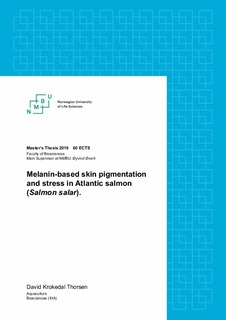| dc.description.abstract | Anybody who has studied, fished for, handled, or consumed Atlantic salmon (Salmo salar) and rainbow trout (Oncorhynchus mykiss) will have noticed that the skin of these fishes is typically dappled with black spots. In recent times, the spots have gained much interest within many study fields, especially stress and animal welfare. Stress is known to have detrimental effects upon growth, reproduction, food conversion efficiency and disease susceptibility, making discoveries of new stress indicators utmost important. Until now, the most utilized method to measure the level of stress has been to analyse the cortisol content in blood plasma. However, this is a time-consuming process and difficult to do in field, and consequently, finding an external indicator of the internal state is of international interest.
Previous studies have found a negative correlation between the number of ectoparasitic adult female salmon lice (Lepeophtheirus salmonis) and the number of spots in Atlantic salmon, in which the highly spotted individuals were found to have less adult female salmon lice than the less spotted individuals. However, these studies utilized a semi-quantitative method, in which spots are counted by eye and then subjectively adjudged depending on size. Consequently, development of automatic image analysis for the recognition and quantification of melanised areas of individual fish would be of great benefit in further research. Therefore, we wanted to investigate if the same correlation between the number salmon lice and the number of spots would be evident when utilizing automatic image analysis. Interestingly, in preliminary studies establishing methodology to quantify spots on the operculum, we noticed that some of the spots had faded and that the frequency of faded spots seemed to increase throughout the sampling session. These observations were made in fish chronically disturbed by ongoing sampling activities, e.g. crowding and netting, the same activities as during delousing procedures. Hence, it would seem that the spots do not only reflect individual stress coping ability, they also convey information about recent exposure to stressful experiences. Thorough research in established literature indicates that the sudden fading phenomenon might be stress-induced. Furthermore, as the fading was visible by the naked eye, our finding might be utilized as a new stress-indicator. This would give rise to a much easier method for detecting stress, as opposed to the blood plasma sampling. However, the fading and cortisol content were not correlated, indicating that other mechanisms are directly involved in fading. The thorough literature review finds that the activation of MCH-Rs and/or norepinephrine-receptors is the main factor in the fading process. In addition, from the results of the spot analysis, we did not find any lateralisation of spots, which in turn means that further spot analysis will only have to be based upon one of the sides. However, as time was plentiful (approximately five hours) during sampling, we cannot conclude which specific molecular process was the main fading agent. Consequently, more research regarding the molecular control of stress-induced fading is crucial in order to establish fading of spots as a marker of stress and welfare in fish aquaculture. | nb_NO |

